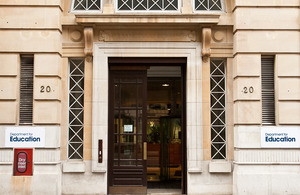GCSE and A level performance tables and school spend data published
Exam performance data 2010 published by the DfE to provide parents with more information about school performance and expenditure.

The Department for Education has today published the 2010 performance tables for GCSEs, A levels and equivalent qualifications.
Parents will, for the first time today, have more information about how schools are performing in providing a rounded academic education for children, along with how they spend their money. In addition, for the first time ever, parents will be able to use the Department for Education website to create their own performance tables that rank local schools or to compare them with others.
Nick Gibb discusses the school performance tables
The figures published show:
- the overall number of 5 GCSE (or iGCSE or equivalent) passes at A* to C including English and mathematics has increased again this year by 3.6 percentage points to 53.4% - around 25,600 more pupils achieving this performance measure than last year;
- 216 schools were below the new floor standard of below 35% achieving 5 GCSEs or equivalents at grades A* to C including English and mathematics and below the average levels of progression in English and mathematics;
- under the new English Baccalaureate measure, 15.6% of pupils in England achieve an A* to C GCSE (or iGCSE) in English, mathematics, sciences, a modern or ancient language and history or geography;
- 53.8% of pupils achieved the new basic measure of achieving English and mathematics GCSEs (or iGCSEs) at grade A* to C;
- academies continue to show improvements in getting 5 good GCSEs (or iGCSEs or equivalents) including English and mathematics at a faster rate of 7.8 percentage points compared to other schools, which improved by 4.5 percentage points;
- Southwark, Thurrock and Westminster are the most improved local authorities in terms of percentage of pupils achieving five GCSE (or iGCSE or equivalent) passes at A* to C including English and mathematics from 2007 to 2010.
Education Secretary Michael Gove said:
This is the most detail parents and the public have ever had about how children are performing in England’s secondary schools.
Children, parents and schools should be proud of their results, which have been achieved through all the hard work they have put in. But as the international evidence from PISA shows us, England still lags behind other nations. We have not succeeded in closing the gap and in raising attainment for all students.
That’s why we are reforming our school system by learning from the best-performing countries. In nearly every other developed country in the world children are assessed in a range of core academic subjects at 15 or 16. That is why the Coalition introduced the English Baccalaureate as a measure of performance.
The key performance measure remains the number of children who get 5 A* to C passes at GCSE including English and maths.
I am open to arguments about how we can further improve every measure in the performance tables - including the English Baccalaureate. But I am determined to ensure that our exam standards match the highest standards around the world.
The spending data published today will also allow parents, researchers and the general public for the first time to look at how much individual schools spent per pupil last year on areas such as teaching staff, energy and catering, to judge if a school is making the best use of the funding allocated to them. Schools can compare how they are spending their money compared to other schools.
Further information
Nick Gibb discusses performance tables An audio recording of the Schools Minister talking about the school performance tables released today.
Parents get more information about school performance Coalition government publishes new data about the performance and expenditure of secondary schools in England.
DfE media enquiries
Central newsdesk - for journalists 020 7783 8300